Language Curriculum
Development of Language and Literacy Skills
Primary School Age
[ 3 ½ to 5 ½ ]
The Optimal Period to
Learn Handwriting and Reading
A typical Vruksha Primary School student can read real books (not just sound out phonetic 3-letter-words),
and pen full sentences in cursive handwriting (not just form a few print capital letters or trace his name.)
For the preschool child, building his vocabulary and learning to handwrite
and to read are arguably the most important academic skills to acquire. The broader his vocabulary, the easier
reading comprehension will be for the child down the road and 3-6 year olds learn even difficult scientific
terms with ease. Thus, developing our student’s vocabulary is an important part of our primary classrooms.
We teach writing and reading early because, as Dr. Montessori has shown, 3 ½ to 5 ½ years are the optimal
ages to learn these skills. Children at that age are interested in the sensations of language its sounds,
the movement the hand makes when writing a letter, the grip of the hand on the pencil and they delight in
the repetition necessary to perfect these skills. By carefully structuring the language program for our
preschool students around their natural interests and abilities, we enable our students to joyfully learn
to write and read long before they enter elementary school and spare them the tedious effort and frustration
that too many kids experience when learning these critical skills in a traditional elementary school setting.
Teaching Approach
Nurturing Language Development in Scientific Steps
In our classrooms, students learn writing and reading by engaging in a carefully graded series of exercises. The activities build upon the child’s interest in Practical Life and Sensorial activities and repetition, and break down the complex skill of writing into manageable components.
1. Indirect preparation
At Vruksha, we begin preparing children for writing as young as 18-months-old. Children in our toddler and preschool programs indirectly prepare for handling a writing instrument by means of various activities that help them to coordinate their fingers and strengthen their pencil grip. For example, when children manipulate cylinders or geometric insets in the Sensorial Materials, they do it by grasping the knob, which is about the same thickness as a pencil, with three fingers. They also use tongs to transfer buttons or small objects from one container to another in Practical Life. And they are guided to touch things lightly when they feel the outlines of wooden inserts or touch different grades of sandpaper in the Sensorial Materials, just as they soon will lightly move a pencil over paper.
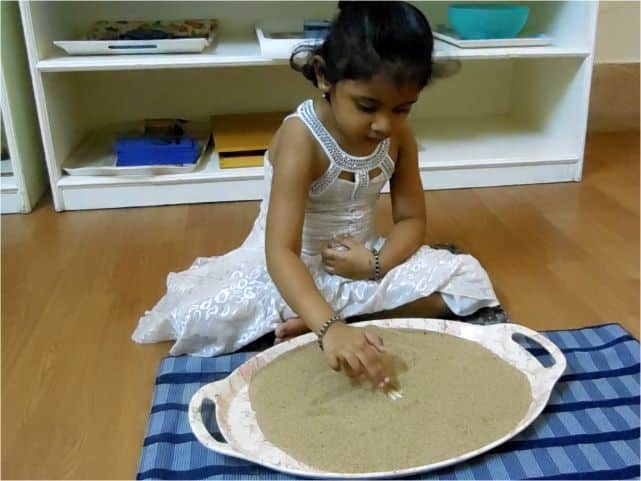
2. Direct preparation
The direct preparation for language that includes both writing and reading development involves sequence of activities for development of tactile, visual and auditory recognition of letters (sandpaper letters, movable alphabet), refinement of muscular coordination and control and development of the ability to use a pencil or chalk: metal insets, chalk boards and then paper. The writing process is orderly and calls for an organised mind. The hand must start at a certain place on the page, letters must be placed in sequence, ideas must be put together so that they make sense, etc. All handwriting work begins with spoken language experience. Letter-Sound Knowledge that is learning the mechanics of creating a letter’s shape as well as its associated sound is the next cornerstone of handwriting.
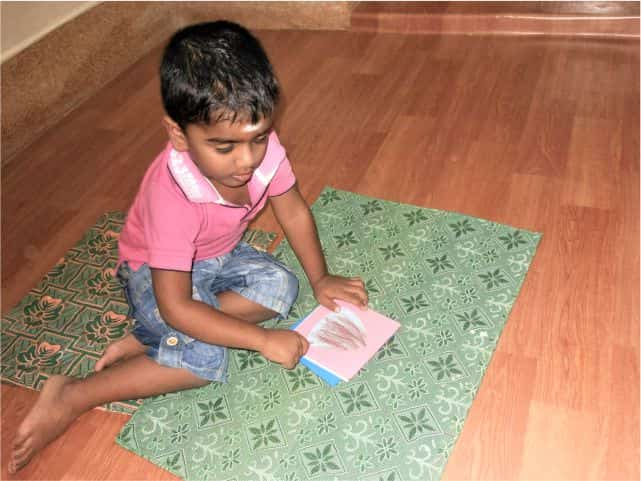
3. Writing & Reading Development
When the child moves into that part of the sensitive period that is toward writing and reading, there are psychic (inner) forces to support symbolic language acquisition. They are Concentration, Purposeful movement, Repetition, Order and Abstraction. To help the child in his development in language, the Montessori classroom is designed to help the child reach the 3rd period of consciousness. Because the learning of language is not done through subjects as in a normal classroom, the child is learning at his own rhythm. This allows the child to concentrate on the learning of each important step in language so that each progressive step is done easily and without any thought on the part of the child. The special material also plays an important role in aiding the child develop the powers of communication and expression, of organization and classification, and the development of thought.
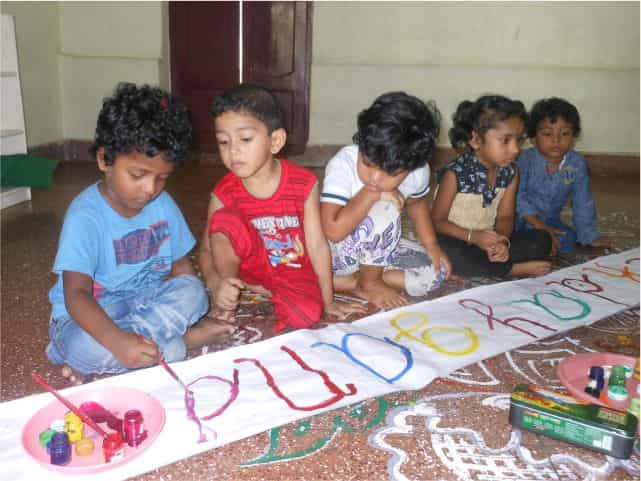
Key Activities
Breaking Down Complex Skills into Enjoyable Component Activities
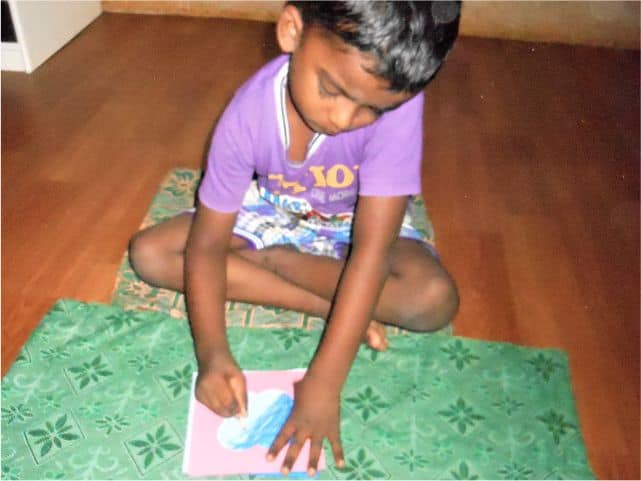
Pencil grip: Metal insets
Building on these motor skills, the child learns to control a pencil; using special materials designed for the purpose, he learns to trace shapes and fill them in using colored pencils. To make the outline, he uses a piece of equipment called the Metal Insets. Each inset represents a different geometric shape. After selecting a figure and tracing it on paper, the child fills in the outline with a colored pencil. At first his strokes are inconsistent and often extend beyond the outline, but over time, as he practices over and over again, the lines become more parallel, and the coloring becomes more even. By combining different insets, children create complex geometric drawings the “art of the inset” in which they take great delight, and which we proudly display in our classrooms.
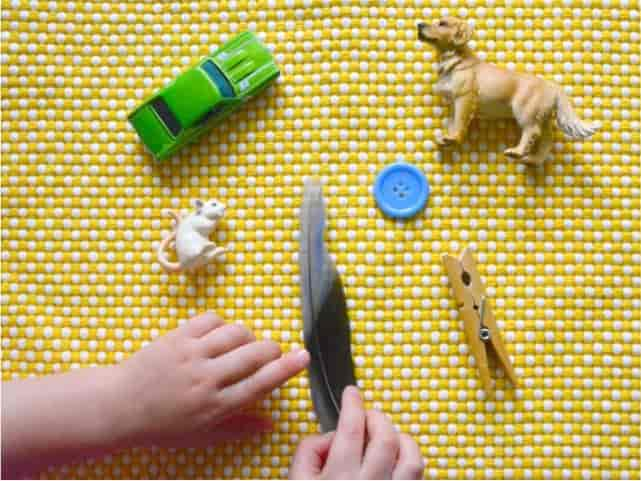
Phonemic awareness: Sound Games
A popular small-group activity in our primary classrooms are the Sound Games. In one of these games, the directress sits on the floor with a few children who have joined her by choice. She has in front of her a basket with different small objects that represent short, phonetic words using the short vowel sounds, such as a bed, a cat, a mat, a box and a cup. She holds up one item, and asks a child to name it. Then, she asks another child to say the beginning sound; the next child, the ending sound; and a fourth, the middle sound. The Sound Games train the children to listen for the sounds that make up the words of our language; they develop the basic phonemic awareness which later enables children to read and write.
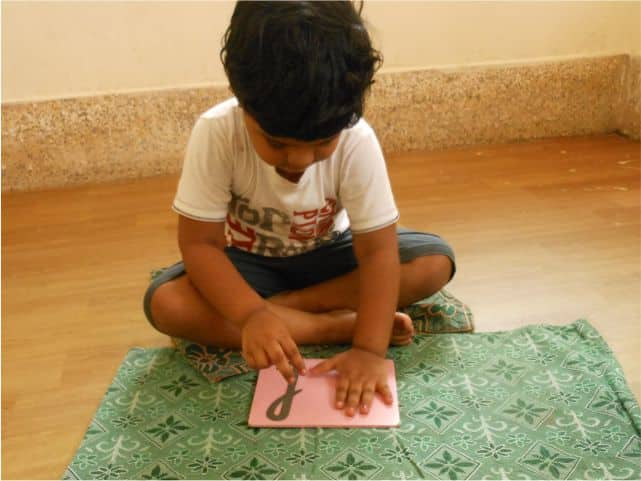
Hand movements and letter-sound-correspondence: Sandpaper Letters
To relate the hand movements necessary for writing with the sounds of the individual letters, Dr. Montessori created Sandpaper Letters. Each letter is cut out of sandpaper and mounted on an individual tablet. The child learns to trace the sandpaper letters with his two working fingers (pointer and middle fingers) while the teacher (and later he) enunciates the corresponding sound. Use of this material gives the child a three-fold impression. He sees the shape, he feels the shape, and he hears the sound of the letter. The fact that the letter is made of sandpaper, rather than ink, invites the child to trace its shape. Observe that this material, like many others in our classrooms, is largely self-correcting, as the child can feel when his hand has erred in tracing the letter.
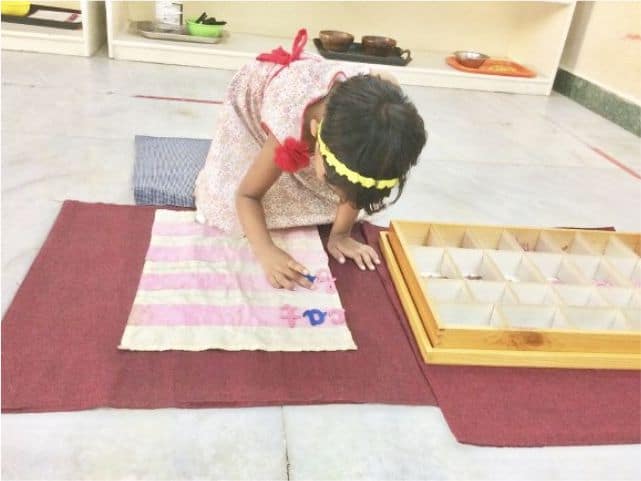
Word building: Movable Alphabet
Next, children learn to compose words with the “movable alphabet,” a boxed set of individual lower-case letters. To begin this activity, the teacher uses the same materials used in the sound games miniature objects representing three letter words with the short vowel sound and a box of lower-case wooden letters of the alphabet. The child selects an object, such as a cat, and slowly says its name, so he can hear each sound – c….a….t. He then selects from the box the letter representing the first sound, and puts it next to the object on his mat. Next, he listens for and selects the second letter, and finally the third. He thus “builds words” without the added complexity of having to form the letters by writing them with a pencil.
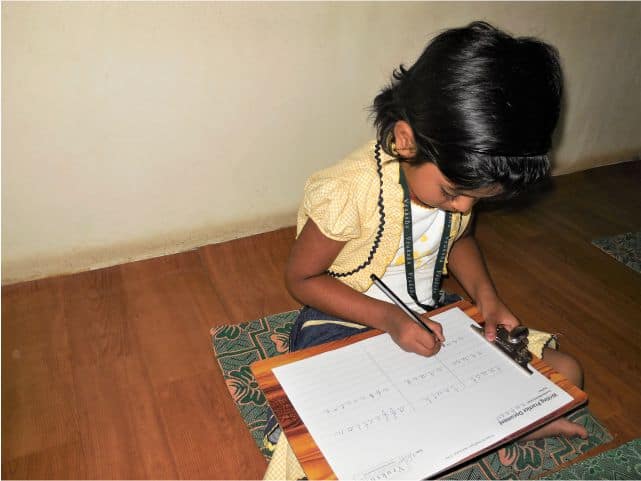
Further writing and reading activities
Once the child has started writing, she naturally progresses to reading. Our classrooms offer a wide variety of reading activities “noun cards”, which children match to pictures; “command cards”, which give a child a command to act out, such as “sit”, or “jump”, and, later, “open and close the door”, or “serve yourself a drink;” phonograms, which introduce sounds of the English language which are made up of two or more letters, such as “sh” as in “ship”, “air” as in “fair” and “tion” as in action. Our students also learn common non-phonetic words, or “puzzle words”, such as “does”, “the” and “one.”
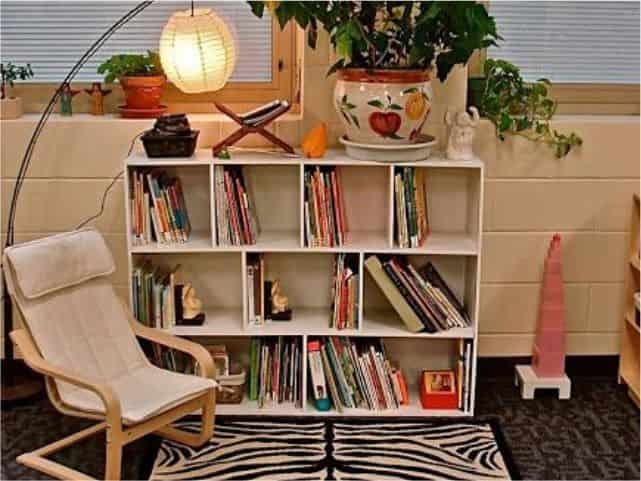
Books – our reading corner
Each Vruksha classroom has a reading shelf and once our students know how to read, we often find them engrossed in a book that interests them, or reading a book to their younger classmates. In our schools, children acquire, from an early age, a love of reading and an ability to learn from books.
Note: In our schools, we begin by teaching cursive handwriting, just like Dr. Montessori did: moving the pen in one smooth motion throughout a word is easier for the child than lifting it for each letter. Cursive writing also eliminates the common error of reversing such letters as “d” and “b”, and it enables the children to write faster and more beautifully, once they become proficient at handwriting. (Contrast this approach with the typical non-Montessori school, where children first learn print letters in Kindergarten, and then have to relearn how to write in 3rd grade, when cursive writing is introduced almost as an afterthought.)
The Results
Reading and Writing - Learned and Loved
Once our students have sufficiently automated the components of handwriting and related the letters to their sounds (typically by age 4 ½ to 5 ½), they arrive at what Dr. Montessori called an “explosion into writing,” whereby they rapidly begin to write whole words with ease.
Shortly after this explosion into writing (and in some cases beforehand), a Vruksha student begins to read. As he has already automated the symbol-sound correspondence by means of the aforementioned materials, he has a strong foundation in phonics. As our focus on vocabulary development is more pronounced, his understanding includes a broad range of concepts. He can therefore decode almost any word he may encounter, and once he sounds out the word and hears it spoken he can recognize it more readily in the future.
Unlike the “look-say” and “whole language” approaches to reading, which attempt to teach children to recognize whole words on sight (treating English as if it were a pictorial system such as Chinese languages) and thus hamper the learning process, our approach to reading is entirely phonics-based. It teaches children to write and to read by focusing first on the shapes and sounds of letters, and then on combinations of letters followed by their corresponding chains of sounds. By providing children with materials that interest them on a sensorial level, and then building step-by-step from that base to the higher-level skills, we help children learn not only to write and read, but also love to write and read.
By the end of Primary (age 5 ½ to 6 ½), a typical Vruksha student demonstrates capabilities that far exceed those of 1st or 2nd graders taught to the English Language Arts Standards:
| Primary Children | Grade this skill is expected from public school students |
|---|---|
| Can write legible sentences in cursive, with proper spacing and alignment on the paper |
Writes legibly in cursive or joined italic – 3rd grade
|
| Can compose short, one-paragraph narratives |
Writes brief narratives describing an experience – 1st grade
|
| Understands and applies the basic phonetic rules on short & long vowels, two- and three-letter phonograms |
Spells basic short vowel, long vowel, r-controlled and consonant-blend patterns correctly – 2nd grade
|
| Knows and can spell correctly the most common non-phonetic or puzzle words |
Spells frequently used irregular words correctly – 2nd grade
|
| Can follow multi-step written commands (command cards) |
Follow one-step written instructions – 1st grade
|
| Can read a wide variety of children’s books, both silently and aloud, with proper intonation and rhythm (Our students read regular books, not vocabulary-controlled primers) |
Reads aloud fluently and accurately, with proper intonation – 2nd grade
|
| Has a broad vocabulary base, including scientific vocabulary in botany, zoology, geography and geometry |
Classifies grade-appropriate collection of words – e.g. collections of animals – 1st grade
|
Get in Touch with Us
Our Headquarters are in Chennai and Puducherry
27-28, 2nd Cross
Moogambigai Nagar
Reddiarpalayam, Pondy - 605 010
Phone: +91 9994851951
Phone: +91 9361919996
Email: contact@vrukshamontessori.com
24-25, 12th Cross
Ranga Reddy Gardens
Neelankarai, Chennai - 600 041
Phone: +91 9994851951
Phone: +91 9361919996
Email: contact@vrukshamontessori.com
We are social
Click For
Contact Us
